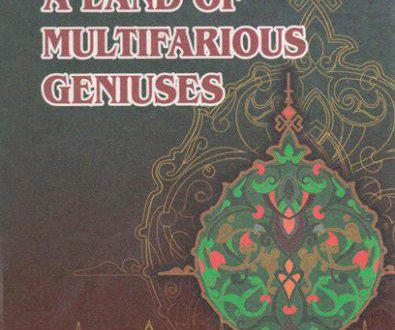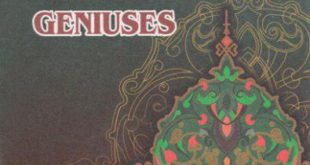Optimistic rays of the independence gained by our country are widening the scale of our thought and making positive changes in it. This pleasant process can be seen in the possibilities provided by the independence to study and understand our ancient and rich history, incomparable resources of our spiritual heritage as well as the growing interest to study and learn the invaluable legacy of our great ancestors who made a substantial contribution to the world civilization. A letter that came to the address of Tashkent Islamic University from Ishtikhan district of Samarkand region can support this idea. The author of the letter that we received wrote the following: “Our Baylata Jome’ mosque is situated in Azamat Collective Farm in Ishtikhan district of Samarkand region. There is a graveyard next to the mosque which keeps the remains of a great scholar Imam Abu-l-Hasan ar-Rustughfani”. Further the author of the letter said that “…one of the books published recently states that Abu-l-Hasan ar-Rustughfani was a student of Imam Abu Mansur al-Maturidi but the other book stresses that al-Maturidi was a student and follower of Abu-l-Hasan ar-Rustughfani. Seeing this difference in ideas, the attendants of our mosque are shattered and astonished. However, we do not know Abu-l-Hasan ar-Rustughfani’s date of birth. We would like you to give us a full definition of this ambiguity” and thus finishes his letter.
Understanding the importance and urgency of the question under discussion and taking into consideration the interest mani-lested by the public, as an answer to the above-mentioned letter we decided to present the information obtained from the historical sources and manuscripts.
It is noteworthy to mention that the information we have at our disposal about Imam Abu-l-Hasan ar-Rustughfani (but not ar-Rastunfani as some sources say) is not so perfect. Nevertheless, the Arabic sources written in the Middle Ages provide some original ideas. As an instance for this case, we can mention the book written by as-Sam’ani “Kitab al-Ansab”, another book “Al-Lubab fi tahziyb al-Ansab” written by Ibn Al-Asir, “Taj at-tarajum” written by Ibn Qutlubugha, “Al-Javahir al-muziya fi tabaqat al-Hanafiyya” written by Muhiddin al-Qurashi, “Al-Favaid al-bahiya fi tarajum al-Hanafiyya” written by Abdulhay al-Laknavi, “Tabsirat al-adilla” written by Abu-l-Muin an-Nasafi, etc. We can also find necessary information about the life and career of Imam Abu-l-Hasan ar-Rustughfani in the works of modern authors. Among them,it is suitable to mention the book written by a German scholar and researcher Ulrich Rudolf under the title of “Al-Maturidi and the Sunni Order in Samarkand” and the book written by a researcher Kamilkhan Kattayev under the title of “Great Geniuses of Samarkand”.
It is a pity that any single historical source does not provide us with information about the date of birth of Imam Abu-l-Hasan ar-Rustughfani but his date of death is mentioned to be 350/961. The authors who wrote about the birthplace of Imam Abu-l-Hasan ar-Rustughfani state that Rustughfan was one of the villages of Samarkand and they stress that Abu-l-Hasan Ali ibn Said ar-Rustughfani was born the this very village. The sources do not provide us with necessary information about his parents. The authors who wrote about the life and career of Imam Abu-l-Hasan ar-Rustughfani pointed out that he was acknowledged as one of the greatest sheikhs and scientists of Samarkand. The essence of the book written by Abu-l-Hasan ar-Rustughfani under the title of “Irshad al-Muhtadi” (A Handbook Leading to the Truth) gives us an idea that he was seriously engaged in the science of kalam founded by his contemporary Imam Abu Mansur al-Maturidi. As an addition to this proof, we can mention that while writing his book “Tabsirat al-adilla” (When Evidences Speak) Abu-l-Muin an-Nasafi, who lived 100 years later than Abu-l-Hasan ar-Rustughfani, cited some ideas from Abu-l-Hasan ar-Rustughfani’s above-mentioned work. Another book written by Abu-l-Hasan ar-Rustughfani is “Kitab fi-l-khilaf” (A Book about Contradictions). It is devoted to the descriptions and definitions of contradictions between different religious teachings. We can assume that this book by Abu-l-Hasan ar-Rustughfani was devoted to the settlement of different viewpoints and contradictions among different trends, i.e. parties and groups in the religion existing in the 9th-10th centuries, and their teachings. Another book written by Imam Abu-l-Hasan ar-Rustughfani was titled as “Kitab az-zavaid va-1 favaid” (A Book about Additional and Useful Things). According to the writings of an Arabian historian Abdulhay al-Laknavi.this book was devoted to the description of characteristic features of different branches of science and education. Relying on these factors, we can assume that Imam Abu-l-Hasan ar-Rustughfani was one of the first scholars to create a special book characterizing different highly developed branches of science of the Middle Ages.
As to the relations between Imam Abu-l-Hasan ar- Rustughfani and Imam Abu Mansur al-Maturidi, we can state that Abu-l-Hasan ar-Rustughfani was one of the most capable and devoted students and disciples of Imam Abu Mansur al-Maturidi who was the greatest scholar and the founder of the science of kalam in the Middle Ages. In the field of Islamic law, he was an independent expert and could reach the status of “mujtahid”. The original sources confirm that there were heated discussions between Imam Abu Mansur al-Maturidi and Imam Abu-l-Hasan ar-Rustughfani on the controversial problems of the Islamic law. As an Arabic historian Muhiddin al-Qurashi states in his book “Al-Javahir al-muziyya fi tabaqat al-Hanafiyya”, there were different viewpoints between Imam Abu Mansur al-Maturidi and Imam Abu-l-Hasan .11-Rustughfani in some matters of the Islamic law.
During our investigations about the life and career of Abu-1-I Iasan ar-Rustughfani in Ishtikhan district of Samarkand, we happened to come across interesting facts about the other scholars who had lived in this area. We suppose it would be interesting for our readers to be aware of these facts. In his book “Al-Lubab fi tahziyb al-Ansab” a well-known Arabic historian ibn al-Asir states that near the town Ishtikhan there was a small village called Ras-taghfor where a famous expert in the science of Hadiths Davud ibn Amru ar-Rastaghfari al-Ishtikhani lived. He is said to have cited some Hadiths from Ahmad ibn Hashim al-Ishtikhani and, in his turn, another scholar Muhammad ibn Ibrahim ibn Hamduvaykh al-Ishtikhani had cited from ar-Rastaghfari. In his book “Kitab al-qand fi zikri ulamai Samarqand” (A Sweet Book about the Scholars of Samarkand), a well-known scholar from Nasaf Najmiddin Umar an-Nasafi presents information about Abu Said Abdurrahman ibn Saad ibn Abu Vaqqas az-Zuhri an-Naysaburi al-Baluvi that he worked in Ishtikhan for some years as a judge and died in 985 in this town, and, in accord with his will, his corpse was taken to Khartang to be buried next to the tomb of the great expert in Hadiths Muhammad ibn Ismail al-Bukhari (810-870).
In conclusion, we can say that lots of great scholars, thinkers and geniuses were educated in various corners of our sacred country who created their immortal works which could serve as considerable contribution to the world civilization. Thanks to the possibilities provided by our independence, we have to study and disseminate these precious ideas among our people. In future, we hope to find out more information about the life and career of Imam Abu-l-Hasan ar-Rustughfani.
 Imom Buxoriy xalqaro ilmiy-tadqiqot markazi bukhari.uz
Imom Buxoriy xalqaro ilmiy-tadqiqot markazi bukhari.uz











